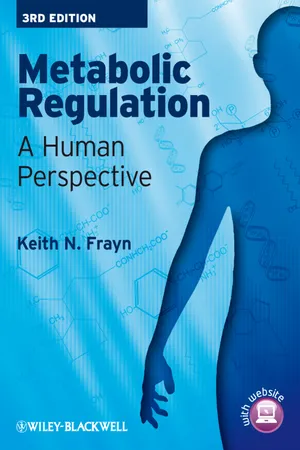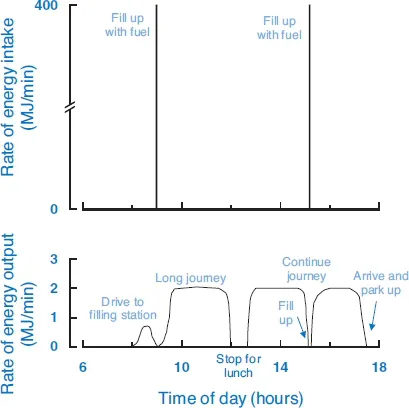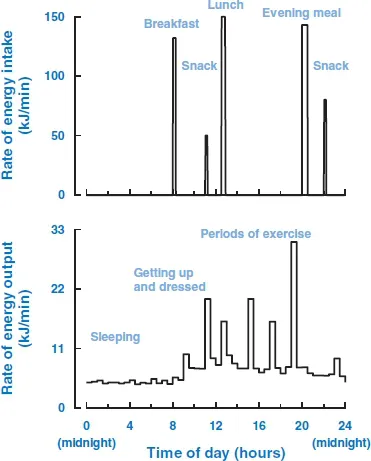![]()
1
The Underlying Principles of Human Metabolism
Key learning points
- We eat food. We expend energy doing exercise, sleeping, just being. What happens to the food between it entering out mouths and its being used for energy? That’s what metabolic regulation (at least, so far as this book is concerned) is all about.
- In order to cover the periods when we are not eating, we need to store metabolic fuels. We store fuel as fat (triacylglycerol) and as carbohydrate (glycogen). Fat provides considerably more energy per gram stored.
- Molecules involved in metabolism differ in an important property: polarity. Polar molecules (those with some degree of electrical charge) mix with water (which is also polar); non-polar molecules, which include most lipids (fatty substances), usually don’t mix with water. This has profound implications for the way they are handled in the body.
- Some molecules have both polar and non-polar aspects: they are said to be amphipathic. They can form a bridge between polar and non-polar regions. Amphipathic phospholipid molecules can group together to form membranes, such as cell membranes.
- The different organs in the body have their own characteristic patterns of metabolism. Substrates flow between them in the bloodstream (circulation). Larger blood vessels divide into fine vessels (capillaries) within the tissues, so that the distances that molecules have to diffuse to or from the cells are relatively small.
1.1 Metabolic Regulation in Perspective
To many students, metabolism sounds a dull subject. It involves learning pathways with intermediates with difficult names and even more difficult formulae. Metabolic regulation may sound even worse. It involves not just remembering the pathways, but remembering what the enzymes are called, what affects them and how. This book is not simply a repetition of the molecular details of metabolic pathways. Rather, it is an attempt to put metabolism and metabolic regulation into a physiological context, to help the reader to see the relevance of these subjects. Once their relevance to everyday life becomes apparent, then the details will become easier, and more interesting, to grasp.
This book is written from a human perspective because, as humans, it is natural for us to find our own metabolism interesting – and very important for understanding human health and disease. Nevertheless, many of the principal regulatory mechanisms that are discussed are common to other mammals. Some mammals, such as ruminants, have rather specialized patterns of digestion and absorption of energy; such aspects will not be covered in this book.
A consideration of metabolic regulation might begin with the question: why is it necessary? An analogy here is with mechanical devices, which require an input of energy, and convert this energy to a different and more useful form. The waterwheel is a simple example. This device takes the potential energy of water in a reservoir – the mill-pond – and converts it into mechanical energy which can be used for turning machinery, for instance, to grind corn. As long as the water flows, its energy is extracted, and useful work is done. If the water stops, the wheel stops. A motor vehicle has a different pattern of energy intake and energy output (Figure 1.1). Energy is taken in very spasmodically – only when the driver stops at a filling station. Energy is converted into useful work (acceleration and motion) with an entirely different pattern. A long journey might be undertaken without any energy intake. Clearly, the difference from the waterwheel lies in the presence of a storage device – the fuel tank. But the fuel tank alone is not sufficient: there must also be a control mechanism to regulate the flow of energy from the store to the useful-work-producing device (i.e., the engine). In this case, the regulator is in part a human brain deciding when to move, and in part a mechanical system controlling the flow of fuel.
What does this have to do with metabolism? The human body is also a device for taking in energy (chemical energy, in the form of food) and converting it to other forms. Most obviously, this is in the form of physical work, such as lifting heavy objects. However, it can also be in more subtle forms, such as producing and nurturing offspring. Any activity requires energy. Again, this is most obvious if we think about performing mechanical work: lifting a heavy object from the floor onto a shelf requires conversion of chemical energy (ultimately derived from food) into potential energy of the object. But even maintaining life involves work: the work of breathing, of pumping blood around the vascular system, of chewing food and digesting it. At a cellular level, there is constant work performed in the pumping of ions across membranes, and the synthesis and breakdown of the chemical constituents of cells.
What is your pattern of energy intake in relation to energy output? For most of us, the majority of energy intake occurs in three relatively short periods during each 24 hours, whereas energy expenditure is largely continuous (the resting metabolism) with occasional extra bursts of external work (Figure 1.2). It is clear that we, like the motor vehicle, must have some way of storing food energy and releasing it when required. As with the motor vehicle, the human brain may also be at the beginning of the regulatory mechanism, although it is not the conscious part of the brain: we do not have to think when we need to release some energy from our fat stores, for instance. Some of the important regulatory systems that will be covered in this book lie outside the brain, in organs which secrete hormones, particularly the pancreas. But whatever the internal means for achieving this regulation, we manage to store our excess food energy and to release it just as we need.
Figure 1.1 Rates of energy intake and output for a motor vehicle. The rate of intake (top panel) is zero except for periods in a filling station, when it is suddenly very high. (Notice that the scales are different for intake and output.) The rate of output is zero while the car is parked with the engine off; it increases as the car is driven to the filling station, and is relatively high during a journey. When totaled up over a long period, the areas under the two curves must be equal (energy intake = energy output) – except for any difference in the amounts of fuel in the tank before and after.
This applies to the normal 24-hour period in which we eat meals and go about our daily life. But the body also has to cope with less well-organized situations. In many parts of the world, there are times when food is not that easily available, and yet people are able to continue relatively normal lives. Clearly, the body’s regulatory mechanisms must recognize that food is not coming in, and allow an appropriate rate of release of energy from the internal stores. In other situations, the need for energy may be suddenly increased. Strenuous physical exercise may increase the total rate of metabolism in the body to twenty times its resting level. Something must recognize the fact that there is a sudden need to release energy at a high rate from the body’s stores. During severe illness, such as infections, the rate of metabolism may also be increased; this is manifested in part by the rise in body temperature. Often the sufferer will not feel like eating normally. Once again, the body must have a way of recognizing the situation, and regulating the necessary release of stored energy.
Figure 1.2 Rates of energy intake and output for a person during a typical day. The rate of energy intake (top panel) is zero except when eating or drinking, when it may be very high. The rate of energy output (heat + physical work) (lower panel) is at its lowest during sleep; it increases on waking and even more during physical activity. As with the car, the pattern of energy intake may not resemble that of energy expenditure, but over a long period the areas under the curves will balance – except for any difference in the amounts of energy stored (mainly as body fat) before and after. Data for energy expenditure are for a person measured in a calorimetry chamber and were kindly supplied by Dr Susan Jebb of MRC Human Nutrition Research, Cambridge.
What we are now discussing is, indeed, metabolic regulation. Metabolic regulation in human terms covers the means by which we take in nutrients in discrete meals, and deliver energy as required, varying from moment to moment and from tissue to tissue, in a pattern which may have no relationship at all to the pattern of intake. Metabolic regulation works ultimately at a molecular level, mainly by modulation of the activities of enzymes. But one should not lose sight of the fact that these molecular mechanisms are there to enable us to lead normal lives despite fluctuations in our intake and our expenditure of energy. In this book, the emphasis will be on the systems within the human body which sense the balance of energy coming in and energy required, particularly the endocrine (hormonal) and the nervous systems, and which regulate the distribution and storage of nutrients after meals, and their release from stores and delivery to individual tissues as required.
The intention of this preamble is to illustrate that, underlying our everyday lives, there are precise and beautifully coordinated regulatory systems controlling the flow of energy within our bodies. Metabolic regulation is not a dry, academic subject thought up just to make biochemistry examinations difficult; it is at the center of human life and affects each one of us every moment of our daily lives.
1.2 The Chemistry of Food – and of Bodies
Energy is taken into the body in the form of food. The components of food may be classified as macronutrients and micronutrients. Macronutrients are those components present in a typical serving in amounts of grams rather than milligrams or less. They are the well-known carbohydrate, fat, and protein. Water is another important component of many foods, although it is not usually considered a nutrient. Micronutrients are vitamins, minerals, and nucleic acids. Although these micronutrients play vital roles in the metabolism of the macronutrients, they will not be discussed in any detail in this book, which is concerned with the broader aspects of what is often called energy metabolism.
The links between nutrition and energy metabolism are very close. We eat carbohydrates, fats, and proteins. Within the body these are broken down to smaller components, rearranged, stored, released from stores, and further metabolized, but essentially whether we are discussing food or metabolism the same categories of carbohydrate, fat, and protein can be distinguished. This is not surprising since our food itself is of organic origin, whether plant or animal.
In order to understand metabolism and metabolic regulation, it is useful to have a clear idea of some of the major chemical properties of these components. This is not intended as a treatise in physical or organic chemistry but as a starting point for understanding some of the underlying principles of metabolism. The discussion assumes a basic understanding of the meaning of atoms and molecules, of chemical reactions and catalysis, and some understanding of chemical bonds (particularly the distinction between ionic and covalent bonding).
1.2.1 Some Important Chemical Concepts
1.2.1.1 Polarity
Some aspects of metabolism are more easily understood through an appreciation of the nature of polarity of molecules. Polarity refers to the distribution of electrical charge over the molecule. A non-polar molecule has a very even distribution of electrical charge over its surface and is electrically neutral overall (the negative charge on the electrons is balanced by the positive charge of the nucleus). A polar molecule has an overall charge, or at least an uneven distribution of charge. The most polar small particles are ions – that is, atoms or molecules which have entirely lost or gained one or more electrons. However, even completely covalently bonded organic molecules may have a sufficiently uneven distribution of electrical charge to affect th...


